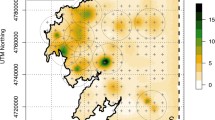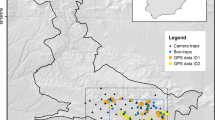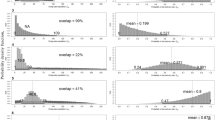Abstract
Knowing the population size of game is a basic prerequisite to determining adequate hunting management and conservation strategies and setting up appropriate hunting quotas. This study compared three methods complete count, capture–recapture and N-mixture modelling to estimate a turtle dove Streptopelia turtur breeding population using nest counts. We randomly sampled 143 fruit farms (60 orange orchards and 83 olive orchards) situated in an irrigated area in Morocco at the peak of breeding activity. We calculated the probability of detecting active turtle dove nests using information from two observers who independently searched the same sample plots. We found that (a) the capture–recapture method provided more precise results of nest abundance than N-mixture modelling, and that (b) the probability of nest detection was noticeably different between the two study orchards—higher in the orange orchards than in the olive orchards. Although these two methods are easy to implement and cost-effective for estimating population abundance on a large spatial scale, our results demonstrate that the resulting estimates are prone to bias depending on the tree height of the plantations. Of the three methods for estimating turtle dove abundance, complete counts were preferable for assessing population size. Using the complete counts, the density of turtle dove nests was found to be 2.96 nests/ha in the orange orchards and 0.93 nests/ha in the olive orchards. A density extrapolation to the entire surface area of the Tadla Region indicated a minimum breeding population size of 58,969 pairs (95 % confidence interval: 48,550–69,353).


Similar content being viewed by others
References
Bacon L (2012) Estimation de la taille de la population de tourterelle des bois nicheuse en France. Master1 IEGB. Université Montpellier 2. 35 pp
Bakaloudis DE, Vlachos CG, Chatzinikos E, Bontzorlos V, Papakosta M (2009) Breeding habitats preferences of the turtledove (Streptopelia turtur) in the Dadia-Soufli National Park and its implications for management. Eur J Wild Res 55:597–602
BirdLife International (2004) Birds in the European Union: a status assessment. BirdLife 519 International, Wageningen
Boutin JM, and Lutz M (2007) Management Plan for Turtle dove (Streptopelia turtur) 2007-2009. European Commission. Luxembourg
Browne S, Aebischer N (2001) The role of agricultural intensification in the decline of the Turtle Dove Streptopelia turtur. English Nature, Peterborough
Browne SJ, Aebischer NJ (2003) Habitat use, foraging ecology and diet of Turtle Doves Streptopelia turtur in Britain. Ibis 145:572–582
Browne SJ, Aebischer NJ, Yfantis G, Marchant JH (2004) Habitat availability and use by Turtle dove Streptopelia turtur between 1965 and 1995: an analysis of Common Birds Census data. Bird Study 51:1–11
Burnham KP, Anderson DR (2002) Model selection and multimodel inference: a practical information theoretic approach. Springer, New York, New York, USA
Buruaga MF, Onrubia A, Fernandez-Garcia JM, Campos MA, Canales F, Unamuno JM (2012) Breeding habitat use and conservation status of the turtle dove Streptopelia turtur in Northern Spain. Ardeola 59:291–300
Couturier T, Cheylan M, Bertolero A, Astruc G, Besnard A (2013) Estimating abundance and population trends when detection is low and highly variable: a comparison of three methods for the Hermann’s Tortoise. J Wildl Manag 77(3):454–462
Cramp S (1985) The birds of the Western Palearctic, vol 4. Oxford University Press, Oxford, UK
Dias S, Moreira F, Beja P, Carvalho M, Gordinho L, Reino L, Oliveira V, Rego F (2013) Landscape effects on large scale abundance patterns of turtle doves Streptopelia turtur in Portugal. Eur J Wildl Res 59:51–541
Dunn JC, Morris AJ (2012) Which features of UK farmland are important in retaining territories of the rapidly declining Turtle dove Streptopelia turtur? Bird Study 59:394–402
Eraud C, Boutin J-M, Riviere M, Brun J, Barbraud C, Lormé H (2009) Survival of turtle doves Streptopelia turtur in relation to western Africa environmental conditions. Ibis 151:186–190
Fiske I., Chandler R (2010) Unmarked: models for data from unmarked animals. R package version.0.8-6.http://ftp.ctex.org/mirrors/CRAN/web/packages/unmarked/unmarked.pdf. Accessed 12 July 2013.
Fontoura P, Dias S (1996) Productivity of a turtle dove (Streptopelia turtur) population in the Northwest of Portugal; In proceeding of: In Botev N (ed) The Game and the Man. Proceedings of the XXII Congress of the IUGB, At Sofia, Bulgaria, Volume: pp:1-6
Frederick PC, Heath JA, Bennetts R, Hafner H (2006) Estimating nests not present at the time of breeding surveys: an important consideration in assessing nesting populations. J Field Ornithol 77:212–219. doi:10.1111/j.1557-9263.2006.00043.x
Hanane S (2009) La Tourterelle des bois au Maroc: sur les traces d’un gibier. Centre de Recherche Forestière, Collection Maroc Nature, Rabat, Morocco. 36 pp
Hanane S (2011) La reproduction de la Tourterelle des bois dans les vergers de Tadla (Maroc Central). Faune Sauvage 293(4):30–31
Hanane S (2012) Do age and type of plantings affect turtle dove Streptopelia turtur nest placement in olive agro-ecosystems? Ethol Ecol Evol 24:284–293
Hanane S (2014) Plasticity in nest placement of the Turtle Dove (Streptopelia turtur): experimental evidence from Moroccan agro-ecosystems. Avian Biol Res 7(2):65–73
Hanane S, Baamal L (2011) Are Moroccan fruit orchards suitable breeding habitats for Turtle Doves Streptopelia turtur? Bird Study 58:57–67
Hanane S, Maghnouj M (2005) Biologie de reproduction de la Tourterelle des bois Streptopelia turtur dans le périmètre irrigué du Haouz (Marrakech- Maroc). Alauda 73:183–194
Hanane S, Besnard A, Aafi A (2012) Factors affecting reproduction of Woodpigeons Columba palumbus in North African forests: 1. Nest habitat selection. Bird Study 59(4):463–473
Haut Commissariat aux Eaux et Forêts et à la Lutte Contre la Désertification (HCEFLCD) (2013) Rapport annuel de la chasse saison 2012/2013. 38 pp
Heath M, Borggreve C, Peet N (2000) European Bird Populations: Estimates and Trends. Birdlife Conservation Series No. 10. Birdlife International/European Bird Census Council, Cambridge. 160 pages
Isenmann P, Moali A (2000) Les Oiseaux d’Algérie. [Birds of Algeria.]. Société d’Étude Ornithologiques de France, Paris. 336 pages
Isenmann P, Gaultier T, El Hili A, Azafzaf H, Dlensi H, Smart M (2005) Oiseaux de Tunisie. [Birds of Tunisia.]. SEOF Editions, Paris, France. 432 pages
Jakob C, Ponce-Boutin F, Besnard A (2014) Coping with heterogeneity to detect species on a large scale: N-mixture modeling applied to red-legged partridge counts. J Wildl Manag 78:540–549
Laâroussi M (2005) Maîtrise de l’irrigation pour une gestion durable du périmètre irrigué de Tadla. Paper presented at the 19th Congress and 56th International Executive Council Meeting, 10–18 September, Beijing, China
Massoni C, Missente G, Ionesco T (1967) Les Cahiers de la Recherche Agronomique 25 : Congrès de pédologie méditerranéenne (1966). Excursion au Maroc, Tome II, 4ième partie : Les profils des sols présentés dans la plaine de Tadla, Chap. I. 5-71
Miller MR, Stemler CL, Yee JL, Blankenship DS (2010) Season, weather, and habitat effects on Mourning dove nest density. Northwest Nat 91:183–197
Office Régionale de Mise en Valeur Agricole de Tadla (ORMVAT) (2013) Monographie. www.ormvat.ma. Accès le 25 juin 2013
Pagano AM, Arnold TW (2009) Detection probabilities for ground-based breeding waterfowl surveys. J Wildl Manag 73(3):392–398
PECBMS (2010) The State of Europe’s Common Birds, 2008. CSO/RSPB, Prague, Czech Republic Plan Maroc Vert, Région de Tadla Azilal, Ministère de l'Agriculture. http://www.fao.org/fileadmin/templates/est/Climate_change/Morocco/Plan_maroc_vert_Tadla_Azilal.pdf, accès le 12 mai 2013
R Development Core Team (2010) R: a language and environment forstatistical computing. R Foundation for Statistical Computing, Vienna, Austria
Rivera-Milan FF (1997) Seasonal and annual changes in the population density of Zenaïda Doves in the Xerophytic forest of Guanica. Puerto-Rico J Field Ornithol 68(2):259–272
Rocha Camarero G, Merchan T, & Hidalgo De Trucios SJ (2006) Otras especies de caza menor en dehesas y bosques mediterráneos: Tórtola Común y Paloma Torcaz. En: Carranza J, Saez de Buruaga M (2006) Manual para la gestión integral de los ecosistemas mediterráneos en los terrenos cinegéticos de andalucía. España
Rouxel R (2000) La tourterelle des bois (Streptopelia turtur): synthèse de donnés bibliographiques en Europe orientale. Bulletin de liaison et d’information d’OMPO. Octobre 22:5-15
Royle JA (2004) N-mixture models for estimating population size from spatially replicated counts. Biometrics 60:108–115
Sauer JR, Hines JE, Fallon JE, Pardieck KL, Ziolkowski Jr DJ, Link WA (2011) The North American Breeding Bird Survey, Results and Analysis 1966-2009. Version 3.23.2011. USGS Patuxent Wildlife Research Center, Laurel, MD
Smith PA, Bart J, Lanctot RB, Mccaffery BJ, Brown S (2009) Probability of detection of nests and implications for survey design. Condor 111(3):414–423
Snow DW, Perrins CM (1998) The Birds of the Western Palearctic. Concise Edition vol. 1 - Non passerines. Oxford University Press : 856-859
Thévenot M, Vernon R, Bergier P (2003) The birds of Morocco. British Ornithologists’ Union/British Ornithologists’ Club, Tring
Tucker GM, Heath MF (1994) Birds in Europe: Their Conservation Status. BirdLife International, Cambridge. 600 pages
Williams BK, Nichols JD, Conroy MJ (2002) Analysis and management of animal populations. Academic Press, San Diego, California, USA
Williams KA, Frederick KA, Peter C, Nichols JD (2011) Use of the superpopulation approach to estimate breeding population size: an example in asynchronously breeding birds. Ecology 92(4):821–828
Author information
Authors and Affiliations
Corresponding author
Additional information
Communicated by P. Acevedo
Electronic supplementary material
Below is the link to the electronic supplementary material.
ESM 1
(DOCX 16 kb)
Rights and permissions
About this article
Cite this article
Hanane, S., Besnard, A. Are nest-detection probability methods relevant for estimating turtle dove breeding populations? a case study in Moroccan agroecosystems. Eur J Wildl Res 60, 673–680 (2014). https://doi.org/10.1007/s10344-014-0836-x
Received:
Revised:
Accepted:
Published:
Issue Date:
DOI: https://doi.org/10.1007/s10344-014-0836-x




